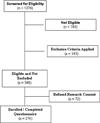Patients rate physician communication about lung cancer
- PMID: 21495028
- PMCID: PMC3267549
- DOI: 10.1002/cncr.26152
Patients rate physician communication about lung cancer
Abstract
Background: High-quality lung cancer care includes physician-patient communication about the disease and treatment, patient needs/preferences, and care goals. In this study, the authors evaluated communication with patients at all stages across multiple topics.
Methods: A standardized questionnaire asked patients with lung cancer to rate (on 5-point, verbal descriptor scale) the extent of communication with physicians on symptoms, spiritual concerns, practical needs, proxy appointment, living will preparation, prognosis, care goals, potential complications of therapy, life support preferences, and hospice. Communication was defined as inadequate if the patient reported discussing ≥5 of 11 questionnaire topics "not at all" or "a little bit." Multivariate logistic regression was used to evaluate the factors associated with inadequate communication.
Results: In total, 276 of 348 (79%) eligible patients were enrolled (mean age [±standard deviation], 65 ± 10 years; 55% white, 21% black, and 19% Hispanic; all disease stages). For most topics, the majority of respondents reported that physicians communicated "not at all" or "a little bit." Low ratings were frequent for discussion of emotional symptoms (56%; 95% confidence interval [CI], 49%-62%), practical needs (71%; 95% CI, 65%-76%), spiritual concerns (80%; 95% CI, 75%-85%), proxy appointment (63%; 95% CI, 57%-69%), living will preparation (90%; 95% CI, 85%-93%), life support preferences (80%; 95% CI, 75%-84%), and hospice (88%; 95% CI, 86%-94%). Communication was inadequate for patients of different ages, stages, and races, although Hispanics were less likely than non-Hispanic whites and blacks to report inadequate communication (odds ratio, 0.31; 95% CI, 0.15-0.65).
Conclusions: Across all stages, patients with lung cancer reported low rates of physician-patient communication on key topics, which may increase patient distress, impair decision-making, and compromise clinical outcomes and use patterns.
Copyright © 2011 American Cancer Society.
Figures


Similar articles
-
Association of Actual and Preferred Decision Roles With Patient-Reported Quality of Care: Shared Decision Making in Cancer Care.JAMA Oncol. 2015 Apr;1(1):50-8. doi: 10.1001/jamaoncol.2014.112. JAMA Oncol. 2015. PMID: 26182303 Free PMC article.
-
Disparities in prognosis communication among parents of children with cancer: The impact of race and ethnicity.Cancer. 2017 Oct 15;123(20):3995-4003. doi: 10.1002/cncr.30960. Epub 2017 Sep 5. Cancer. 2017. PMID: 28873224
-
Factors associated with decisions to undergo surgery among patients with newly diagnosed early-stage lung cancer.JAMA. 2010 Jun 16;303(23):2368-76. doi: 10.1001/jama.2010.793. JAMA. 2010. PMID: 20551407 Free PMC article.
-
Patient-physician racial concordance and the perceived quality and use of health care.Arch Intern Med. 1999 May 10;159(9):997-1004. doi: 10.1001/archinte.159.9.997. Arch Intern Med. 1999. PMID: 10326942
-
Folic acid supplementation and malaria susceptibility and severity among people taking antifolate antimalarial drugs in endemic areas.Cochrane Database Syst Rev. 2022 Feb 1;2(2022):CD014217. doi: 10.1002/14651858.CD014217. Cochrane Database Syst Rev. 2022. PMID: 36321557 Free PMC article.
Cited by
-
Disparities in Supportive Care Needs Over Time Between Racial and Ethnic Minority and Non-Minority Patients With Advanced Lung Cancer.J Pain Symptom Manage. 2022 Apr;63(4):563-571. doi: 10.1016/j.jpainsymman.2021.12.007. Epub 2022 Jan 11. J Pain Symptom Manage. 2022. PMID: 35031503 Free PMC article.
-
Impact of Community Health Workers on Elderly Patients' Advance Care Planning and Health Care Utilization: Moving the Dial.Med Care. 2017 Apr;55(4):319-326. doi: 10.1097/MLR.0000000000000675. Med Care. 2017. PMID: 27875482 Free PMC article.
-
Informational Needs of Lung Cancer Patients and Caregivers.J Cancer Educ. 2025 Jan 6. doi: 10.1007/s13187-024-02560-4. Online ahead of print. J Cancer Educ. 2025. PMID: 39757335
-
Patient perceptions regarding the likelihood of cure after surgical resection of lung and colorectal cancer.Cancer. 2015 Oct 15;121(20):3564-73. doi: 10.1002/cncr.29530. Epub 2015 Jun 19. Cancer. 2015. PMID: 26094729 Free PMC article.
-
Breaking silence: a survey of barriers to goals of care discussions from the perspective of oncology practitioners.BMC Cancer. 2019 Feb 8;19(1):130. doi: 10.1186/s12885-019-5333-x. BMC Cancer. 2019. PMID: 30736754 Free PMC article.
References
-
- Griffin JP, Koch KA, Nelson JE, Cooley ME. Palliative care consultation, quality-of-life measurements, and bereavement for end-of-life care in patients with lung cancer: ACCP evidence-based clinical practice guidelines (2nd edition) Chest. 2007;132(3 suppl):404S–422S. - PubMed
-
- Hagerty RG, Butow PN, Ellis PM, et al. Communicating with realism and hope: incurable cancer patients’ views on the disclosure of prognosis. J Clin Oncol. 2005;23:1278–1288. - PubMed
Publication types
MeSH terms
Grants and funding
LinkOut - more resources
Full Text Sources
Medical

